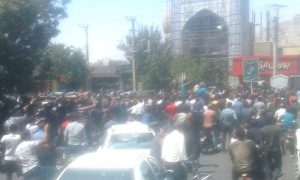
A large number of protesters take to the streets of Isfahan their dissatisfaction and outrage over the high prices and plunge in rial
The truckers and lorry drivers strike has drawn attention from the Iranian population, the regime, and the international media. This attention led to large crowds in Ishafan gathering in support of the striking truck drivers.
On August 1st, 2018, the strike from owners and truck drivers in Isfahan entered its second day. As the protest spread, shopkeepers, young Iranians, and other civilians disenfranchised by the mullahs’ repressive and violent regime took to the streets. The crowd marched down the city’s main streets, chanting “death to the dictator”, “death to high prices, death to unemployment”, and “incompetent officials resign, resign”.
A National Crisis
The truck driver’s strike in Isfahan is one part of a wider, national strike, undertaken by truck drivers over poor working conditions and economic decline. The most recent national strike began on July 24th, quickly spreading to major Iranian cities, including Mashhad, Qazvin, Farrokh Shahr, and Marand.
#IranProtests#Iran opposition NCRI issues a report on the fourth consecutive day of truckers' strike throughout the country.https://t.co/skOLG6IoXf
— People's Mojahedin Organization of Iran (PMOI/MEK) (@Mojahedineng) July 26, 2018
The protests are crippling the Iranian infrastructure. Videos and images of, normally bustling, loading terminal stations in Khomeini Port sitting empty are circulating online.
The truck drivers are demanding an increase in wages, which have stagnated despite soaring inflation, lowered insurance premiums, lowered prices for replacement truck parts, and reduced highway tolls. The first round of strikes, which began in May and lasted for 11 days, did not yield results.
Commission fees have become a way for the mullahs to extort money from the nation’s truckers. The state-run ILNA news agency reported that logistics firms have to pay transport commissions of up to 10% of the cargo’s worth. Some shipment companies have been reported asking commissions up to 40%.
On top of these crippling fees, increasing fuel prices and highway tolls eat into the truck driver’s meager earnings. The state-run Mehr news agency reported that Iranian truck driver’s earnings do not adequately cover their expenses, leaving many facing financial ruin.
The Regime’s Aggressive Response
Much like the May strike, the latest round of strikes has been met with an aggressive response from the regime. In Isfahan, the regime sent its security forces to disperse the crowds and bombarded those gathered with tear gas.
The protestors in Isfahan fought back against the agents of the regime. They burnt tyres to mask the tear gas. They would not be deterred and continued their protests in the face of mounting oppression.
A Mounting Protest Movement
The trucker’s protest is just one part of Iran’s growing opposition protest movement. The People’s Mujahedin Organisation of Iran (MEK) has been a driving force behind a growing opposition movement. Maryam Rajavi, leader of Iran’s main opposition and the President-elect of the National Council of Resistance of Iran (NCRI) has been instrumental in drawing support and international recognition for the Iranian opposition movement. Rajavi threw her support behind the Iranian truck drivers, and all those resisting the mullahs’ rule across Iran.
On July 31st, the people of Karaj mounted their own protest, taking over Gohardasht First Square. Again, the regime fought to bring the situation under control, but the determined people of Karaj erected barricades to block the movement of the regime’s forces.
Staff Writer
